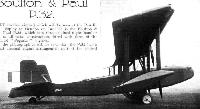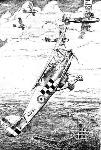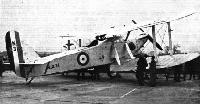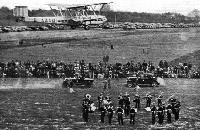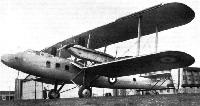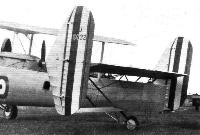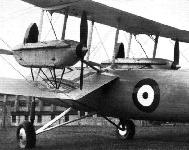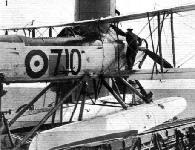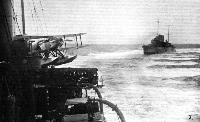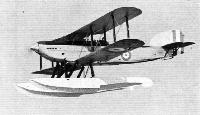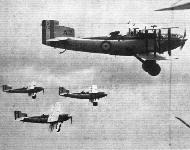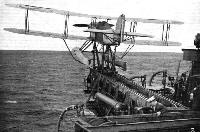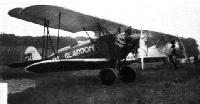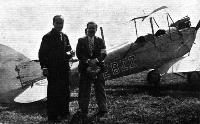Фотографии
-
Регистрационный номер: G-ABPE, S1592 SOME OF THE PERFORMERS AT HANWORTH: A large variety of aircraft types was demonstrated, ranging from the Comper "Swift" (Pobjoy) to the Hawker "Hart" (Kestrel) and Fairey "Firefly III" (Kestrel).
Самолёты на фотографии: Comper Swift / CLA.7 - Великобритания - 1930Fairey Firefly - Великобритания - 1925Hawker Hart - Великобритания - 1928
-
INTERESTING MACHINE AT ORLY: The Bleriot Channel type monoplane as used by Bleriot in his Channel flight of 1909.
Самолёты на фотографии: Bleriot Bleriot-XI - Франция - 1909
-
BRISTOL "BULLDOG III A" ("Mercury").
Самолёты на фотографии: Bristol Bulldog - Великобритания - 1927
-
OLD AND NEW IN THE TOUR OF FRANCE: The first away was the old Farman 40 pusher (80-h.p. Renault), built in 1912.
Самолёты на фотографии: Farman Farman-30/40 - Франция - 1915
-
Four of Cornwall Aviation Co’s red Avro 504Ks over Whitchurch, June 4, 1932. These were used primarily for joy-riding.
Самолёты на фотографии: Avro Avro 504 - Великобритания - 1913
-
Регистрационный номер: G-EBXK The Westland "Wessex" (three Genet Majors) which came over from Yeovil.
Самолёты на фотографии: Westland Wessex / Westland IV - Великобритания - 1929
-
Регистрационный номер: G-AAVO The Phillips & Powis "Desoutter" (Hermes) piloted by Mr. S. Cliff winning by a short head from Mr. Norman Edgar in the "Elf" (Hermes).
Самолёты на фотографии: Koolhoven FK-41 - Нидерланды - 1928Parnall Elf - Великобритания - 1929
-
Регистрационный номер: G-EBJJ, VH-URJ Mr. Norman Edgar's depot with three of his Parnall "Elfs" and a "Wee Bee" lined up for inspection.
Самолёты на фотографии: Beardmore W.B.XXIV Wee Bee - Великобритания - 1924Parnall Elf - Великобритания - 1929
-
Регистрационный номер: J9950 THE BOULTON & PAUL P.32 NIGHT BOMBER: The Central "Pegasus" engine is mounted on the top centre section, with the result that the view for pilot and front gunner is excellent.
Самолёты на фотографии: Boulton Paul P.32 - Великобритания - 1931
-
The Lockheed "Orion" of Swissair landing at Le Bourget Aerodrome
Самолёты на фотографии: Lockheed Orion 9 - США - 1931
-
Регистрационный номер: K1932 Intercepting: A Hawker "Fury" (Rolls Royce "Kestrel") climbing to the attack.
Самолёты на фотографии: Hawker Fury - Великобритания - 1931
-
Регистрационный номер: N231 Самолёты на фотографии: Blackburn Ripon / T.5 - Великобритания - 1926
-
Регистрационный номер: K2012 Hawker "Audax" (Rolls-Royce "Kestrel" IB)
Самолёты на фотографии: Hawker Audax - Великобритания - 1931
-
Регистрационный номер: F-AKEN INTERESTING MACHINE AT ORLY: Codos and Robida's Paris-Saigon record Breguet 27.
Самолёты на фотографии: Breguet Br.270 / Br.330 - Франция - 1929
-
ANOTHER NEW AIRCRAFT TYPE WHICH WILL BE SEEN AT THE DISPLAY AT HENDON ON JUNE 25: The Fairey Night Bomber (two Rolls-Royce "Kestrel" engines) is the only monoplane among the new machines of this class. It has a wing span of more than 100 ft., and the gross weight is 19,050 lb.
Самолёты на фотографии: Fairey Gordon / Seal - Великобритания - 1931Fairey Hendon - Великобритания - 1930
-
Регистрационный номер: N230 A Vickers "Vildebeest" (Bristol "Pegasus") with which No.100 B.S. is to be re-equipped this summer.
Самолёты на фотографии: Vickers Vildebeest / Type 132 - Великобритания - 1928
-
Регистрационный номер: K2570 DE HAVILLAND "TIGER MOTH": "Gipsy III" engine.
Самолёты на фотографии: De Havilland Tiger Moth / D.H.82 - Великобритания - 1931
-
Регистрационный номер: D-2100 Count Arco-Zinneberg and Capt. Bistritschan starting on the Austrian Rund-Flug in the former's Klemm (Pobjoy).
Самолёты на фотографии: Klemm L.25 - L.28 Swallow - Германия - 1927
-
Регистрационный номер: D-1916 MACHINES AT THE INTERNATIONAL AVIATION MEETING, ST. GERMAIN-EN-LAYE: Miss Liesel Bach (Germany) and her Klemm (100-h.p. inverted Argus).
Самолёты на фотографии: Klemm L.25 - L.28 Swallow - Германия - 1927
-
Регистрационный номер: G-ABVV LUXURY FOR THE PRIVATE OWNER: Major J. E. D. Shaw, who flies at Heston, has recently acquired this Avro "Cadet" (7 cyl. Genet). It has very complete dual controls.
Самолёты на фотографии: Avro Cadet / Type 631/643 - Великобритания - 1932
-
Регистрационный номер: G-AAXC The Lord Mayor of London, Sir Maurice Jenks, and party make a tour of inspection of Croydon Aerodrome before flying to Lancashire in a Handley Page 42 airliner on June 6.
Самолёты на фотографии: Handley Page H.P.42 / H.P.45 - Великобритания - 1930
-
Регистрационный номер: G-AAXD The Band of the Coldstream Guards in the foreground competing with the four "Jupiter" engines of Horatius at Heston.
Самолёты на фотографии: Handley Page H.P.42 / H.P.45 - Великобритания - 1930
-
NIGHT LIFE: (Left to right) Lt. Com. Geoffrey Rodd, R.N., who brought over Rear-Admiral A. L. Snagge (Chairman of the Royal Naval Flying Club); Miss Winifred Spooner, pilot to Mr. Lindsay Everard, whom she flew down from Ratcliffe, talking to Mr. Nigel Norman on their arrival at Heston.
Самолёты на фотографии: De Havilland Puss Moth / D.H.80 - Великобритания - 1929
-
Регистрационный номер: G-ABUJ THE EXHIBITION: Many machines and engines were exhibited in the hangars at Brooklands on Saturday; here are seen the latest Hermes II with enclosed valve gear and lacquer finish, and also the "Puss Moth" of the Anglo-American Oil Go.
Самолёты на фотографии: De Havilland Puss Moth / D.H.80 - Великобритания - 1929
-
Самолёты на фотографии: Hawker Osprey - Великобритания - 1930
-
REAL INTEREST: A formation flight in "Albatros As" aircraft by pilots of the ''Deutsche Verkehrsfliegerschute" on the occasion of the International Flying Meeting at Tempelhof Aerodrome, Berlin, June 12.
Самолёты на фотографии: Albatros L.75 Esel - Германия - 1928
-
Регистрационный номер: S1263 THE BLACKBURN "IRIS III": THIS FLYING BOAT OF ALL-METAL CONSTRUCTION, IS THE MOST POWERFUL MACHINE OF ITS TYPE IN USE AT PRESENT.
Самолёты на фотографии: Blackburn Iris / R.B.1 - Великобритания - 1926
-
NOT A NEW TYPE OF "MOTH" SEAPLANE: This photograph shows the force-recording undercarriage used at Felixstowe for taxying tests of large-scale models of flying-boat hulls (in this case that of a Short "Singapore II").
Самолёты на фотографии: Short Singapore I / S.5 - Великобритания - 1926
-
ARMSTRONG WHITWORTH "ATLAS II" ("Panther III").
Самолёты на фотографии: Armstrong Whitworth Atlas / Ajax - Великобритания - 1925
-
Регистрационный номер: K1311 Самолёты на фотографии: Vickers Victoria - Великобритания - 1922
-
Регистрационный номер: G-ABKW BLACKBURN 10-PASSENGER CIVIL BIPLANE: The two engines are "Jaguars."
Самолёты на фотографии: Blackburn CA.15 Monoplane/Biplane - Великобритания - 1932
-
Left to right: Herr Karl Winkler; Capt. Norman Blackburn (Director and Manager of North Sea Aerial & General Transport Co. Flying School); Herr Kurt Breugmann. Taken before a Blackburn "Bluebird IV" upon which these two German visitors have recently learnt to fly at Brough.
Самолёты на фотографии: Blackburn Bluebird / L.1 - Великобритания - 1924
-
Регистрационный номер: N9694 Самолёты на фотографии: Blackburn Swift T.1 / Dart T.2 - Великобритания - 1920
-
Over the bombing target. Night bombers do not bomb from such a low altitude but no picture could be made from their normal height.
Самолёты на фотографии: Vickers Virginia - Великобритания - 1922
-
No. 58 (Bomber) Squadron: A Flight above the clouds.
Самолёты на фотографии: Vickers Virginia - Великобритания - 1922
-
No.7 (Bomber) Squadron: Three "Virginias" in formation.
Самолёты на фотографии: Vickers Virginia - Великобритания - 1922
-
Three "Virginias" of No. 58 (Bomber) Squadron on day raid.
Самолёты на фотографии: Vickers Virginia - Великобритания - 1922
-
A Flight of No. 7 (Bomber) Squadron.
Самолёты на фотографии: Vickers Virginia - Великобритания - 1922
-
Bombing up: Fixing a 550-lb. bomb in its rack.
Самолёты на фотографии: Vickers Virginia - Великобритания - 1922
-
Officers and Pilots of No. 7 B.S. with the Minor Trophy.
Самолёты на фотографии: Vickers Virginia - Великобритания - 1922
-
Officers and Pilots of No. 58 B.S.
Самолёты на фотографии: Vickers Virginia - Великобритания - 1922
-
Vickers Virginia Mark X
Самолёты на фотографии: Vickers Virginia - Великобритания - 1922
-
Регистрационный номер: G-ABWW PRINCE OF WALES' KING'S CUP ENTRY: The Comper "Swift," with de Havilland "Gipsy III" engine, generally resembles the standard Pobjoy-engined "Swift" except for the nose of the fuselage. A brief description of this machine, and scale drawings, was published in our issue of June 3, 1932.
Самолёты на фотографии: Comper Swift / CLA.7 - Великобритания - 1930
-
Comper "Swift" D.H. Gipsy III Engine
Самолёты на фотографии: Comper Swift / CLA.7 - Великобритания - 1930
-
Самолёты на фотографии: Handley Page Hyderabad/H.P.24 / Hinaidi/H.P.33 / Clive/H.P.35 - Великобритания - 1923
-
Самолёты на фотографии: Handley Page Hyderabad/H.P.24 / Hinaidi/H.P.33 / Clive/H.P.35 - Великобритания - 1923
-
Регистрационный номер: S1275 Самолёты на фотографии: Fairey Flycatcher - Великобритания - 1922
-
Регистрационный номер: G-ABVI THE FIRST PRODUCTION MODEL: The de Havilland "Fox Moth" (Gipsy III) has now gone into production, and the first of the batch, very effectively painted, was delivered to Hillman's Saloon Coaches 8C Airways on Saturday last.
Самолёты на фотографии: De Havilland Fox Moth / D.H.83 - Великобритания - 1932
-
Регистрационный номер: J9832 [4] Самолёты на фотографии: Gloster TC.33 Goshawk - Великобритания - 1932
-
Регистрационный номер: J9832 [4] THE UNUSUAL TAIL UNIT: The horizontal tail surfaces are of sesquiplane form, while the large fins and rudders close in the ends of the tail.
Самолёты на фотографии: Gloster TC.33 Goshawk - Великобритания - 1932
-
Регистрационный номер: J9832 [4] LOW FRONTAL AREA: This front view illustrates the clean design which characterises the Gloster Troop Carrier.
Самолёты на фотографии: Gloster TC.33 Goshawk - Великобритания - 1932
-
Регистрационный номер: J9832 [4] THE TANDEM ENGINE ARRANGEMENT: The four Rolls-Royce "Kestrel" engines (supercharged) are mounted in tandem pairs between the wings, the nacelles being, it will be seen, of good shape and smooth lines.
Самолёты на фотографии: Gloster TC.33 Goshawk - Великобритания - 1932
-
"THE FIRES OF FATE": R.A.F. Co-operation has been secured by British International Pictures, Ltd., for a film they are making in Egypt with the above title. This photograph shows a Fairey III F. flying over a detachment of the Camel Corps.
Самолёты на фотографии: Fairey Fairey IIIF - Великобритания - 1926
-
Регистрационный номер: S1781 Our photograph shows the Fairey IIIF Fleet Spotter Reconnaissance aircraft (Napier "Lion") run back on the catapult and being prepared for flight.
Самолёты на фотографии: Fairey Fairey IIIF - Великобритания - 1926
-
A view looking aft, at the IIIF on the port catapult, and it shows another cruiser, H.M.S. Norfolk, Capt. J. F. Somerville, R.N., also of the 2nd Cruiser Squadron, keeping station astern.
Самолёты на фотографии: Fairey Fairey IIIF - Великобритания - 1926
-
The aircraft is not intentionally being maltreated, but merely being hooked on to the crane preparatory to being hoisted on board again; the slings are secured either side of the top centre section.
Самолёты на фотографии: Fairey Fairey IIIF - Великобритания - 1926
-
Самолёты на фотографии: Fairey Fairey IIIF - Великобритания - 1926
-
Регистрационный номер: S1202 Самолёты на фотографии: Fairey Fairey IIIF - Великобритания - 1926
-
A rear view, showing the IIIF in the stowed position ready for sea; the special jury struts from the floats to the wings and between the ailerons and flaps should be noted; these are fitted to prevent racking stresses when at sea.
Самолёты на фотографии: Fairey Fairey IIIF - Великобритания - 1926
-
INTERESTING MACHINE AT ORLY: The "Marcel Lalouette" Farman 190 used by Goulette and Salel in their Paris-Cape flight.
Самолёты на фотографии: Farman F.190 / F.390 - Франция - 1928
-
OLD AND NEW IN THE TOUR OF FRANCE: Of more recent origin was the Farman 234 (95-h.p. Salmson).
Самолёты на фотографии: Farman F.230 / F.350 - Франция - 1930
-
SARO "CUTTY SARK" AMPHIBIAN: Two de Havilland "Gipsy II" engines.
Самолёты на фотографии: Saunders-Roe Cutty Sark / A.17 - Великобритания - 1929
-
CIRRUS IN U.S.A.: The Great Lakes Sports Trainer fitted with the American Cirrus engine is a popular type with American private owners.
Самолёты на фотографии: Great Lakes 2-T-1 - США - 1929
-
[Model 2T-2 Speedster] The reliable Cirrus engine is as well known in the Americas as it is in England and here may be seen the latest Great Lakes Sports Trainer with the American Cirrus HI-Drive inverted engine. The undercarriage also appears to be fitted with Goodyear airwheels.
Самолёты на фотографии: Great Lakes 2-T-1 - США - 1929
-
Регистрационный номер: G-ABUZ [2] Самолёты на фотографии: General Aircraft Monospar ST-4 - ST-12 - Великобритания - 1932
-
Регистрационный номер: G-ABUZ [2] THE ST. 4: The first of the General Aircraft Monospar machines has now been repaired after its recent mishap, when it collided with a fence and damaged a wing tip. The machine has already flown for more than 5 hours and is said to handle very well, while the landing speed is remarkably low.
Самолёты на фотографии: General Aircraft Monospar ST-4 - ST-12 - Великобритания - 1932
-
MACHINES AT THE INTERNATIONAL AVIATION MEETING, ST. GERMAIN-EN-LAYE: The Raab-Katzenstein biplane (120 Siemens) flown by the Swiss Ace, Victor Glardon.
Самолёты на фотографии: Raab-Katzenstein RK.1 Schwalbe / RK.2 Pelikan / RK.9 Grasmucke - Германия - 1926
-
Регистрационный номер: G-ABOB ECHOES OF HENDON: Col. L. Strange takes his Spartan "Arrow" round the pylon in the true Hendon style, losing less than anyone on his turns.
Самолёты на фотографии: Spartan Arrow - Великобритания - 1930
-
Самолёты на фотографии: Supermarine Southampton / Solent - Великобритания - 1925
-
Регистрационный номер: F-ALOB THE TOUR OF FRANCE: Some of the machines outside the hangar at Orly before the start on June 4.
Самолёты на фотографии: Potez Potez 36 - Франция - 1929
-
Регистрационный номер: G-ABTR A new version of that excellent aircraft for joy-riding - the Spartan 3-seater - which was seen at Heston during Henly's Rally on Saturday, June 4.
Самолёты на фотографии: Simmonds Spartan - Великобритания - 1928
-
Регистрационный номер: G-EBZZ THE I.O.M. WINNERS: Mr. J. R. Ashwell-Cooke (right) with his "Moth" (Cirrus III), in which he won the "Round the Isle of Man" Race. On the left is Mr. Campbell Black, recently back from Kenya, who acted as navigator.
Самолёты на фотографии: De Havilland Gipsy Moth / Moth X - Великобритания - 1928
-
Регистрационный номер: K1217 DE HAVILLAND "GIPSY MOTH": "Gipsy II" engine.
Самолёты на фотографии: De Havilland Gipsy Moth / Moth X - Великобритания - 1928
-
THE NEW ITEM: F/O. Thorn's wireless-controlled flying was a feature of the meeting. His Standard wireless receiver is here seen in the cockpit, while above, the arrangement of the hood is shown.
Самолёты на фотографии: De Havilland Gipsy Moth / Moth X - Великобритания - 1928
-
VICKERS "JOCKEY" ("Jupiter VII F").
Самолёты на фотографии: Vickers Jockey / Type 151 - Великобритания - 1930
-
Flt. Lt. J. Armour pilots a "Professor" at the London Gliding Club's ground on Dunstable Downs at Totternhoe.
Самолёты на фотографии: Lippisch / RRG Professor - Германия - 1928
-
GLIDERS AT ORLY: The Avia school glider, used by Abrial and Remy.
Самолёты на фотографии: Lippisch / RRG Zogling - Германия - 1926
-
Регистрационный номер: D-2200 MACHINES AT THE INTERNATIONAL AVIATION MEETING, ST. GERMAIN-EN-LAYE: G. Fieseler's "Tiger F.2" (340-h.p. Walter engine) which was built to his design at the Kassel Aeroplane Works.
Самолёты на фотографии: Raab-Katzenstein RK.26 Tigerschwalbe - Германия - 1929
-
IM RUCKENFLUG: Herr Fieseler used his new "Tiger 2" at the International Flying Meeting at Tempelhof Aerodrome, Berlin, and he appears to be equally at home either side up.
Самолёты на фотографии: Raab-Katzenstein RK.26 Tigerschwalbe - Германия - 1929
-
GLIDERS AT ORLY: A Kassel glider used by G. Abrial
Самолёты на фотографии: Kassel Kassel 25 / 20 - Германия - 1930
-
Регистрационный номер: F-ALQX MACHINES AT THE INTERNATIONAL AVIATION MEETING, ST. GERMAIN-EN-LAYE: The Weyman two-seater cabin Autogiro (100-h.p. Hispano Suiza).
Самолёты на фотографии: Weymann CTW 200 - Франция - 1932
-
Регистрационный номер: G-ABUI A NEW TYPE OF "MOTH": A recent addition to the de Havilland "family" is the wooden "Moth" shown here. It is fitted with the inverted "Gipsy III" engine, so that purchasers who prefer this engine can now be suited.
Самолёты на фотографии: De Havilland Moth Major / D.H.60GIII - Великобритания - 1932
Статьи
- Flight








